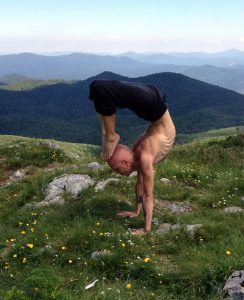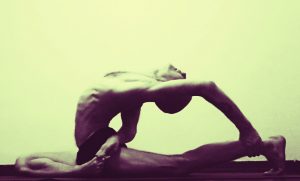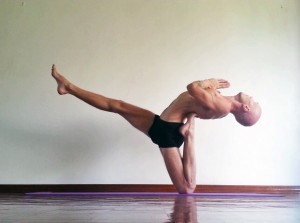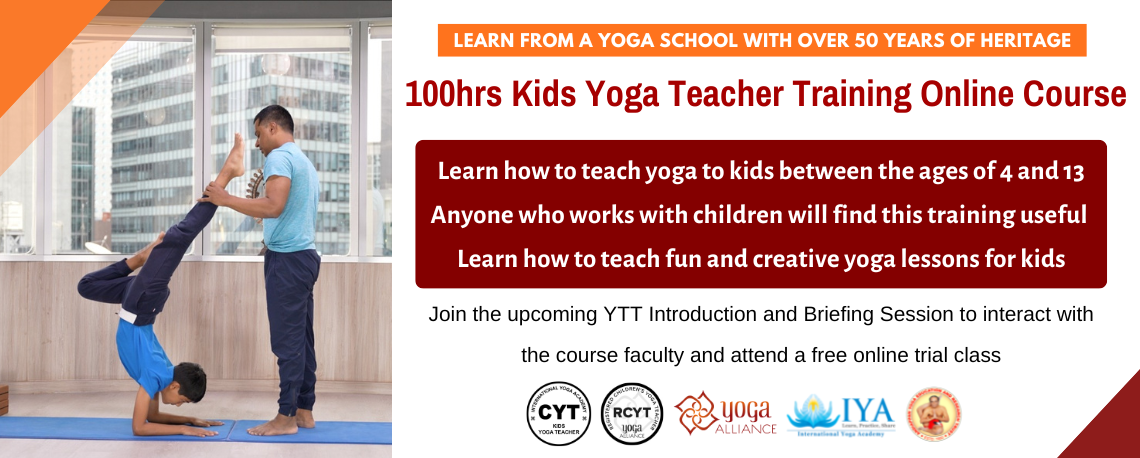Jani Jaatinen aka Mahayogi Gokul has been practicing bot and Ashtanga yoga every day for over 15 years. He has integrated those spiritual practices as a big part of his life. He undertook extensive yoga training from various masters, mainly with Janne Kontala.
Asana talked to Mahayogi about his yoga journey, his teaching and decision to relocate to Kota Kinabalu, Malaysia.
The Practice
 Asana: How did you discover yoga? What attracted you to the practice?
Asana: How did you discover yoga? What attracted you to the practice?
Mahayogi: I got first interested in philosophical side of yoga and then started to practice bhakti yoga after coming contact with Gaudiya-Vaishnavism. Soon after that, I met my teacher, Janne Kontala who introduced me to asana practice.
I got attracted to bhakti yoga tradition’s holistic and common sense way to see the world and goal of life. What comes to physical part of the yoga, I found it as relatively simple and effective way to keep up health and mental stability.
Asana: Which is your favourite practice style – Hatha or Ashtanga?
Mahayogi: My main practice is Bhakti and I like more slow pace Hatha. Classical Patanjali’s Ashtanga is fascinating as psychological system.
Asana: Having undertaken training with various international masters, has your practice changed in the past fifteen years?
Mahayogi: I mainly studied with one teacher, Janne Kontala and most of the inspiration comes from that direction. Yes, it has evolved during the years but same time basic elements have been staying as same as when started.
Asana: Were you born flexible? How do you maintain your practice and get into these challenging poses?
Mahayogi: At the beginning, I was quite average what comes to flexibility. I proceeded slowly with systematic and regular practice. I was lucky to find a good teacher. Also vegetarian diet, regulated living habits and meditation support the practice.
The Teaching
 Asana: Have you ever thought of pursuing a yoga career from graphic design? Can you apply any aspects in your academic training in your teaching?
Asana: Have you ever thought of pursuing a yoga career from graphic design? Can you apply any aspects in your academic training in your teaching?
Mahayogi: Studies of graphic design had helped to develop some visual eye what comes to observing alignment of the poses. I also do most of our Shala’s visual identity.
Asana: Please explain Ananda Vrindavan Champu. What is the most important aspect you convey in your teaching and inspire your students?
Mahayogi: Ananda Vrindavan Champu is an old Vaishnava text which I currently translate into Finnish (my native language). Studying yoga scriptures is like a meditation for me.
Asana: Do you teach primarily visitors at your yoga shala? Does it feel different from teaching regular members at a yoga studio?
Mahayogi: I have solid group of regular students I teach in my yogashala. I prefer to work with same people. It takes time to start to know the person and his/her practice.
But we have also quite many visitors coming and going in our shala and I also try to serve them with the best of my ability.
Asana: Having taught and conducted workshops and retreats in various places around the world, from southeast Asia to Australia, From India to Europe, do you note significant differences in yoga practice amongst various cultures, geographic locations?
Mahayogi: Yes, people have different mentality in different places. My experience is that in Australia and Northern, Europe they share quite similar practice mentality. In Asia, things seem to move faster pace (there is pros and cons in that). I think it is important to understand people’s psychology and learn a bit about their cultural background to make teaching more effective.
The Lifestyle
 Asana: Do you consider yoga has changed your life and lifestyle?
Asana: Do you consider yoga has changed your life and lifestyle?
Mahayogi: Yes it has. Quite a bit. I am very much indebted to many (specially my Gurudev and Janne) who helped me with my journey. Yoga have made my life more simple.
Asana: How did you decide to relocate to Kota Kinabalu and set up your own yoga shala? Is life very different from Finland to now, Malaysia?
Mahayogi: My wife is from KK. We lived first one year in Finland and then decided to move to Malaysia to try out. Their warm climate was one of the main reasons to move there.
Life is quite different in Malaysia than in Finland. We have small active yoga community in KK and because of that, I quite like it there now.
Asana: Does your wife, Jaci, also practice yoga? Do you get support from your family to pursue a career in yoga?
Mahayogi: Jaci is also practicing and teaching yoga. She has been great help for me. I can concentrate well into my practice and teaching now. She is the main person who is keeping our shala up. I am very grateful to Jaci.
Asana: What is your typical day? How do you relax yourself when you are not teaching?
Mahayogi: I wake up about 4am, do my pranayama, mantra meditation and asana practice, finishing 8 am, then I teach a class, about 75-90 mins. Then I go swim in the sea. That is my way to relax.
Later, I do some writing and reading. Afternoon I do restorative practice and chanting (about 1,5 hrs).
Evening I teach one or two classes and do some pranayama, asana and read yoga texts (like Bhagavad Gita, Bhagavata Purana etc) before going to sleep at 9 pm.
I really enjoy it when I can have regular, scheduled life. That is luxury to me.
The Way Forward
 Asana: Is Ananda Vrindavan Champu 6 on the drawing board?
Asana: Is Ananda Vrindavan Champu 6 on the drawing board?
Mahayogi: Yes, I am working on it. Slowly 🙂
Asana: Is there a location you wish to visit, teach or live?
Mahayogi: I’m quite happy where I am at the moment. It is nice to do workshops in different places but still my long time favourite is my yearly pilgrimage to holy city of Vrindavan, India.
Asana: What do you wish to achieve in yoga?
Mahayogi: There is an old Vedic belief that if you keep your goals secret, you will achieve them more easily. So I don’t answer to this 😉
Asana: What is your vision and aspiration?
Mahayogi: I hope our global yoga community turns more into subtle aspects of yoga tradition and works more and more with spiritual side of the practice.
Through our conversation, Mahayogi showed and shared his love and knowledge of yoga. He enjoys what he describes as a “simple life” which is a luxury to most; and not so easy for city people to achieve. His dedication and devotion for yoga is a true inspiration for everyone who has the chance to study yoga with him!
Reputation in the entertainment sector so they know they are safe and in good hands. To those who still struggle, I love to give them the quote by Eleanor Roosevelt, “do something every day that truly frightens you.”
Asana: Which is the most favourite pose?
Mahayogi: Everyone has a favourite pose for their own reason, but the one pose that exists in all the AntiGravity techniques is the Monkey Inversion because zero-compression inversions feels so good!
Asana: Which is the most challenging pose?
Mahayogi: People like the challenge of Vitruvian Man and Falling Star as they both came from the Aerial Arts and require strength, flexibility, courage and body awareness.
To read the full article please download our Asana Journal App or purchase Issue 153 Sept 2015.




















 Other
Other